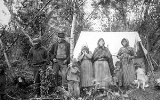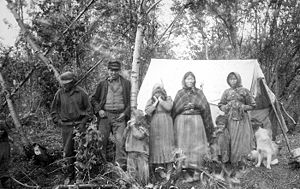
Koyukon
Encyclopedia
The Koyukon are a group of Athabaskan
people living in northern Alaska
. Their traditional home is along the Koyukuk
and Yukon
rivers where they subsisted by hunting and trapping for thousands of years. Many Koyukon live in a similar manner today.
The Koyukon language
belongs to a widespread family called Na-Dene or Athabaskan
spoken by native people scattered throughout northwestern North America
and in pockets as far south as California
and Arizona
.
ns, who came up the Yukon River to Nulato in 1838. When they arrived they found that items such as iron pots, glass beads, cloth apparel, and tobacco had already reached the people through trade with coastal Eskimo
s. An epidemic of smallpox
had preceded them as well, and in subsequent years European diseases drastically reduced the Koyukon population.
Relative isolation persisted along the Koyukuk until 1888, when the Yukon Gold Rush brought more than a thousand men to the river. They found little gold, and most left the following winter.
 As the Koyukon reckon it, all things human and natural go back to a time so remote that no one can explain or understand how long ago it really was. However ancient this time may be, its events are recounted accurately and in great detail through a prodigious number of stories.
As the Koyukon reckon it, all things human and natural go back to a time so remote that no one can explain or understand how long ago it really was. However ancient this time may be, its events are recounted accurately and in great detail through a prodigious number of stories.
The stories constitute an oral history of the Koyukon people and their environment, beginning in an age before the present order of existence was established. During this age "the animals were human"—that is, they had human form, they lived in a human society, and they spoke human (Koyukon) language. At some point in the Distant Time certain humans died and were transformed into animal or plant beings, the species that inhabit Koyukon country today. These dreamlike metamorphoses left a residue of human qualities and personality traits in the north-woods creatures.
Taken together, the Distant Time stories describe a primordial world and its transfiguration into modern form. The scope of Distant Time stories ranges from the minute to the cosmological. The explain the beginnings of entities that inhabit the sky—the sun, moon, and aurora. They account for certain weather phenomena, such as thunderstorms, which are the transformed embodiment of a formerly human spirit.
At the end of Distant Time there was a great catastrophe. The entire earth was covered by a flood, and under the Raven's supervision a pair of each species went aboard a raft. These plants and animals survived, but when the flood ended they could no longer behave like people. All the Distant Time humans had been killed, and so Raven recreated people in their present form. The Koyukon believe that nature is God, which is why they must respect it.
Athabaskan languages
Athabaskan or Athabascan is a large group of indigenous peoples of North America, located in two main Southern and Northern groups in western North America, and of their language family...
people living in northern Alaska
Alaska
Alaska is the largest state in the United States by area. It is situated in the northwest extremity of the North American continent, with Canada to the east, the Arctic Ocean to the north, and the Pacific Ocean to the west and south, with Russia further west across the Bering Strait...
. Their traditional home is along the Koyukuk
Koyukuk River
The Koyukuk River is a principal tributary of the Yukon River, approximately 500 mi long, in northern Alaska in the United States.It drains an area north of the Yukon on the southern side of the Brooks Range...
and Yukon
Yukon River
The Yukon River is a major watercourse of northwestern North America. The source of the river is located in British Columbia, Canada. The next portion lies in, and gives its name to Yukon Territory. The lower half of the river lies in the U.S. state of Alaska. The river is long and empties into...
rivers where they subsisted by hunting and trapping for thousands of years. Many Koyukon live in a similar manner today.
The Koyukon language
Koyukon language
Koyukon is an Athabaskan language spoken along the Koyukuk and middle Yukon River in western interior Alaska. It has about 300 speakers - generally older adults bilingual in English - from an ethnic population of 2,300....
belongs to a widespread family called Na-Dene or Athabaskan
Athabaskan languages
Athabaskan or Athabascan is a large group of indigenous peoples of North America, located in two main Southern and Northern groups in western North America, and of their language family...
spoken by native people scattered throughout northwestern North America
North America
North America is a continent wholly within the Northern Hemisphere and almost wholly within the Western Hemisphere. It is also considered a northern subcontinent of the Americas...
and in pockets as far south as California
California
California is a state located on the West Coast of the United States. It is by far the most populous U.S. state, and the third-largest by land area...
and Arizona
Arizona
Arizona ; is a state located in the southwestern region of the United States. It is also part of the western United States and the mountain west. The capital and largest city is Phoenix...
.
History
The first Europeans to enter Koyukon territory were RussiaRussia
Russia or , officially known as both Russia and the Russian Federation , is a country in northern Eurasia. It is a federal semi-presidential republic, comprising 83 federal subjects...
ns, who came up the Yukon River to Nulato in 1838. When they arrived they found that items such as iron pots, glass beads, cloth apparel, and tobacco had already reached the people through trade with coastal Eskimo
Eskimo
Eskimos or Inuit–Yupik peoples are indigenous peoples who have traditionally inhabited the circumpolar region from eastern Siberia , across Alaska , Canada, and Greenland....
s. An epidemic of smallpox
Smallpox
Smallpox was an infectious disease unique to humans, caused by either of two virus variants, Variola major and Variola minor. The disease is also known by the Latin names Variola or Variola vera, which is a derivative of the Latin varius, meaning "spotted", or varus, meaning "pimple"...
had preceded them as well, and in subsequent years European diseases drastically reduced the Koyukon population.
Relative isolation persisted along the Koyukuk until 1888, when the Yukon Gold Rush brought more than a thousand men to the river. They found little gold, and most left the following winter.
Distant time

The stories constitute an oral history of the Koyukon people and their environment, beginning in an age before the present order of existence was established. During this age "the animals were human"—that is, they had human form, they lived in a human society, and they spoke human (Koyukon) language. At some point in the Distant Time certain humans died and were transformed into animal or plant beings, the species that inhabit Koyukon country today. These dreamlike metamorphoses left a residue of human qualities and personality traits in the north-woods creatures.
Taken together, the Distant Time stories describe a primordial world and its transfiguration into modern form. The scope of Distant Time stories ranges from the minute to the cosmological. The explain the beginnings of entities that inhabit the sky—the sun, moon, and aurora. They account for certain weather phenomena, such as thunderstorms, which are the transformed embodiment of a formerly human spirit.
At the end of Distant Time there was a great catastrophe. The entire earth was covered by a flood, and under the Raven's supervision a pair of each species went aboard a raft. These plants and animals survived, but when the flood ended they could no longer behave like people. All the Distant Time humans had been killed, and so Raven recreated people in their present form. The Koyukon believe that nature is God, which is why they must respect it.
Further reading
- Hunn, E.S. & Williams, N.M.(Eds.). (1982). Resource Managers: North American and Australian Hunter-Gatherers. Westview Press: Colorado. Nelson, R.K. “A Conservation Ethic and Environment: The Koykon of Alaska” p. 211-228 Rohrlich, R & Baruch, E. (Ed.). (1984).
- Naciente, Esperanza. "Indigenous Lifestyles: Lessons for the Industrialized World." Fighting For Freedom Because A Better World Is Possible Eds. Edgey Wildchild and Esperanza Naciente. New York: Planting Seeds Press. 2006. 121-126.
- Nelson, Richard K. Make Prayers to the Raven: A Koyukon View of the Northern Forest. Chicago: University of Chicago Press, 1986. ISBN 0226571637
- Nelson, Richard K., Kathleen H. Mautner, and G. Ray Bane. Tracks in the Wildland: A Portrayal of Koyukon and Nunamiut Subsistence. [Fairbanks]: Anthropology and Historic Preservation, Cooperative Park Studies Unit, University of Alaska, Fairbanks, 1982.
- Peter, Adeline. Iñuksuk: Northern Koyukon, Gwich'in & Lower Tanana, 1800-1901. Fairbanks, AK: Alaska Native Knowledge Network, 2001. ISBN 1877962376

